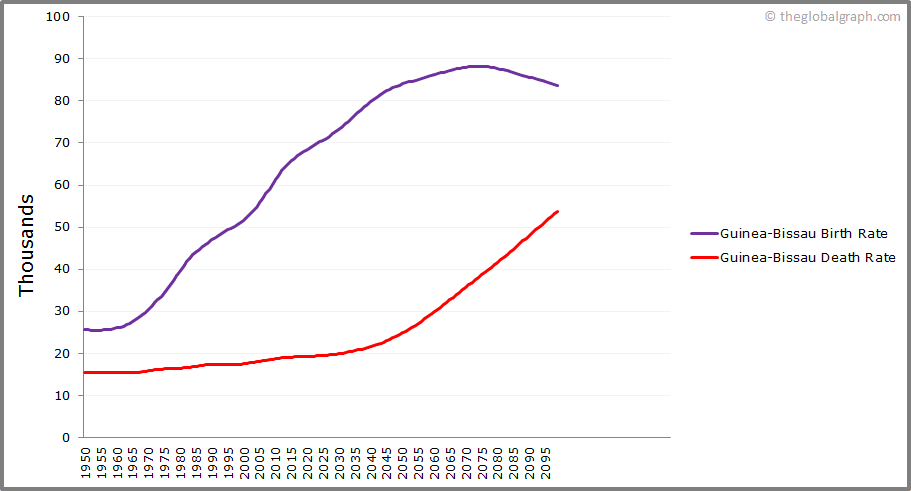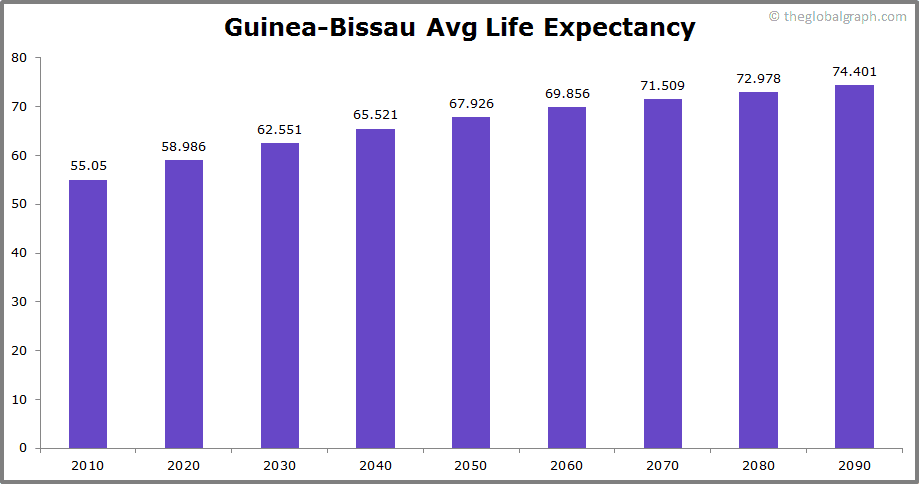Highlights of Analysis:
- Guinea-Bissau Population is increasing
- Guinea-Bissau Population Density is increasing
- Guinea-Bissau Life Expectancy is increasing
- Guinea-Bissau Fertility Rate is decreasing
Every year Guinea-Bissau population is expected to increase by 48274 people. Guinea-Bissau contributes 0.03% of world's total population. Average Life Expectancy in Guinea-Bissau is 58.986 and is expected to Increase in upcoming next 50 years.Life Expectancy is below average when compared to global average (Currently Hong Kong Ranks 1st for Life Expectancy of 85 years).
How the
world population is changing is of great importance for humanity’s impact on the Earth’s natural environment, but it also gives reasons to hope for a good future.
Guinea-Bissau owns 0.00019% of land i.e. 28120 Sq Kms of land and Ranks 142
when compared to other
Global Countries Land area
Guinea-Bissau Population, Density, Fertility Rate and Life Expectancy Overview
| Guinea-Bissau Population Analysis |
Year 2010 |
Year 2020 |
Year 2030 |
| Guinea-Bissau Population (in million)
|
1.55 |
2 |
2.49 |
| Guinea-Bissau Global Rank
|
151st |
150th |
148th |
| Guinea-Bissau Global Population Share
|
0.02% |
0.02% |
0.02% |
| Guinea-Bissau Global Population Density
|
50.83 |
63.71 |
78.25 |
| Guinea-Bissau Global Population Density Rank
|
190th |
192nd |
194th |
| Guinea-Bissau Average Life Expectancy
|
55.05 |
58.98 |
62.55 |
| Guinea-Bissau Average Life Expectancy Global Rank
|
189th |
191st |
193rd |
| Guinea-Bissau Fertility Rate
|
5.04 |
4.33 |
3.71 |
| Guinea-Bissau Fertility Rate Global Rank
|
27th |
26th |
27th |
Note : Population Density means number of people staying per kilometer and Fertility rate means number of kids born per women
What is the Population trend of
Guinea-Bissau
?
- Every year Guinea-Bissau population is expected to increase by 48274 people.
- Guinea-Bissau population overall trend is expected to be Decreasing for next 50 years and expected to be in Decreasing trend for next 100 years.
- Guinea-Bissau will see more birth rate than death rate for next 100 years.
- Guinea-Bissau Global Population Rank for next 50 years is expected to be in Range of 150th-136th.
What is the Population growth rate of
Guinea-Bissau
?
- Guinea-Bissau population average growth rate for next 50 years is increasing at Rate of 1.71%.
- Overall population growth rate of Guinea-Bissau is expected to be decreasing.
- Guinea-Bissau contributes 0.03% of world's total population.
Table : Past and Expected Future
Population & Global Rank
| Year |
Count(in Millions) |
Global Rank |
| 2010 |
1.55 Million |
151st |
| 2020 |
2 Million |
150th |
| 2030 |
2.49 Million |
148th |
| 2040 |
3.03 Million |
143rd |
| 2050 |
3.6 Million |
136th |
| 2060 |
4.16 Million |
134th |
| 2070 |
4.69 Million |
131st |
| 2080 |
5.17 Million |
130th |
| 2090 |
5.57 Million |
129th |
| 2100 |
5.9 Million |
126th |
Table : Past and Expected Future Population Growth Rate
| Year |
Count(in Millions) |
Growth Rate |
| 2010 |
1.55 Million |
2.53% |
| 2020 |
2 Million |
2.25% |
| 2030 |
2.49 Million |
1.95% |
| 2040 |
3.03 Million |
1.72% |
| 2050 |
3.6 Million |
1.46% |
| 2060 |
4.16 Million |
1.19% |
| 2070 |
4.69 Million |
0.97% |
| 2080 |
5.17 Million |
0.75% |
| 2090 |
5.57 Million |
0.55% |
| 2100 |
5.9 Million |
0.38% |
Table : Past and Expected Future Population Share in world
| Year |
Count(in Millions) |
Share |
| 2010 |
1.55 Million |
0.02% |
| 2020 |
2 Million |
0.02% |
| 2030 |
2.49 Million |
0.02% |
| 2040 |
3.03 Million |
0.03% |
| 2050 |
3.6 Million |
0.03% |
| 2060 |
4.16 Million |
0.04% |
| 2070 |
4.69 Million |
0.04% |
| 2080 |
5.17 Million |
0.04% |
| 2090 |
5.57 Million |
0.05% |
| 2100 |
5.9 Million |
0.05% |
Guinea-Bissau
Population Density
- Guinea-Bissau population density is 95.04 per sq. km and is expected to be Decreasing for next 50 years.
- Guinea-Bissau Ranks in range of 192nd-200th in term of population density around the world.
- As per trend, their will be decrease in population density of Guinea-Bissau.
Table : Past and Expected Future Population Density (people per sq. km.)
`
| Year |
Population Density |
Rank |
| 2010 |
50.83 |
190th |
| 2020 |
63.71 |
192nd |
| 2030 |
78.25 |
194th |
| 2040 |
93.7 |
196th |
| 2050 |
109.69 |
198th |
| 2060 |
129.83 |
200th |
| 2070 |
148.06 |
202nd |
| 2080 |
162.65 |
204th |
| 2090 |
172.09 |
206th |
| 2100 |
175.34 |
208th |
Guinea-Bissau
Average Life Expectancy
- Average Life Expectancy in Guinea-Bissau is 58.986 and is expected to Increase in upcoming next 50 years.
- Life Expectancy is below average when compared to global average (Currently Hong Kong Ranks 1st for Life Expectancy of 85 years).
- Guinea-Bissau ranks 191st in terms of average life expectancy around the world.
Table : Past and Expected Average Life Expectancy (Age) (Source)
| Year |
Average Life Expectancy |
Rank |
| 2010 |
55.05 |
189th |
| 2020 |
58.98 |
191st |
| 2030 |
62.55 |
193rd |
| 2040 |
65.52 |
190th |
| 2050 |
67.92 |
191st |
| 2060 |
69.85 |
191st |
| 2070 |
71.5 |
190th |
| 2080 |
72.97 |
189th |
| 2090 |
74.4 |
188th |
| 2100 |
0 |
|
Guinea-Bissau
Average Fertility Rate
- In Guinea-Bissau, Women gives birth to 4.335 (average) children every year and this fertility rate is expected to be in decreasing trend.
- Guinea-Bissau rank is in range of 26th-29th in term of average fertility rate around the world.
Table : Past and Expected Average Fertility Rate
| Year |
Average Fertility Rate |
Rank |
| 2010 |
5.04 |
27th |
| 2020 |
4.33 |
26th |
| 2030 |
3.71 |
27th |
| 2040 |
3.24 |
30th |
| 2050 |
2.9 |
30th |
| 2060 |
2.64 |
29th |
| 2070 |
2.43 |
29th |
| 2080 |
2.26 |
27th |
| 2090 |
2.12 |
26th |
| 2100 |
2.02 |
28th |
Conclusion of Analysis :
In 1950, Guinea-Bissau population was 535430 and this continuously increasing at growth rate of average 0.01%.Currently Guinea-Bissau population is around 1555880 and by year 2030 its expected to be 2492580 .Guinea-Bissau ranks 151st when compared to other countries population. Average Life Expectancy of Guinea-Bissau in 2010 was 55.05, in 2020 its 58.986 and by 2050 it will be 67.926.As mentioned in Highlight's Guinea-Bissau population is increasing, population density is increasing, average life expectancy is increasing and average fertility rate is decreasing.
Reference (Source) :
- https://population.un.org/wpp/
- https://population.un.org/wpp/DataSources/
- https://www.wikipedia.org/
Historical population data on a sub-national level – including their administrative divisions and principal towns – is collected by Jan Lahmeyer and published at his website
www.populstat.info.
The Minnesota Population Center publishes various high-quality datasets based on census data beginning in 1790. At the time of writing this source was online at
www.pop.umn.edu/index.php. It focuses on North America and Europe.
The Data & Information Services Center (DISC) Archive at University of Wisconsin-Madison provides access to census data and population datasets (mostly for the Americas). At the time of writing this source was online at
http://www.disc.wisc.edu.
The Atlas of the Biosphere publishes data on Population Density. At the time of writing this source was online at
www.sage.wisc.edu/atlas/maps.
This research was last modified on
.







